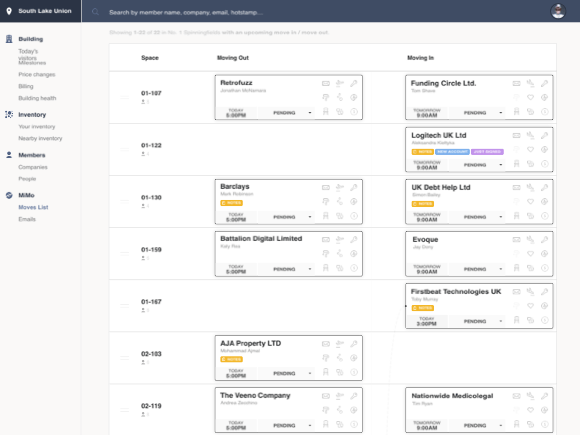
USER EXPERIENCE
WEWORK MOVE TRACKER
Company:
Wework
Product:
MIMO Tracker (Move in / Move out)
Year:
2018 - 2020
My Roles:
End-to-end design (research, concepts to final designs)
MIMO Tracker on Wework's "Spacestation" system
The Challenge:
MIMO is short for Move In / Move Out. It can narrowly be considered to be the process in which "members" (how Wework refers to its tenants) leave a Wework office, and are replaced by a different company instead.
In the broader sense, this is the entire onboarding and offboarding process of companies in and out of Weworks. It’s an elaborate logistical procedure that includes scheduling move times, communicating to companies everything they need to know, managing cleaning and facilities crews to make sure the office is in perfect shape, managing keys and keycards, putting logos on the doors and more. The process typically takes place in the start and end of each month, and its complexity is dependent on multiple parameters - building size, number of moves, office capacity, number of internal moves (companies moving within the building) and more.

Community teams in each building crafted their own spreadsheet to support the MIMO process
Previously, the MIMO process was managed by each building’s community team (the people in charge of operating the building from sales to front desk duties) as they see fit. The process would typically be managed using simple spreadsheet documents, listing all the different moves expected this month, and highlighting what parts of the preparation were completed or not. Apart from the long hours needed to create the document and keep it up to date, this process was also incredibly error prone, and varied in its execution and detail from building to building.
Research:
The onboarding process onto Wework, was mapped by creating an elaborate user journey map, which reviewed all relevant users, their pain points and the opportunities for improvement. The journey spanned the process from initial communication with the company, preparation, move-in, and acclimation into the new surroundings, looking at all affected participants (primarily the incoming members, and the buildings’ community teams).
Research included shadowing several Wework buildings and teams during crucial MIMO days, interviews with relevant stakeholders, both members and community teams, testing concepts and prototypes, and one very quick MVP to test out a simple concept of marking completed status for basic actions.

Journey map created by the Wework research team highlighted the pain points for members and community teams and provided the foundation for the suite of MIMO features and products

A lean experiment released on an existing system, testing the use of toggleable icons as a simple way to mark and track progress - with inconclusive results

First prototype shown to community teams in user interviews
Several drafts were created for a centralized tool with the purpose of allowing community teams to get all the information they need, and perform all actions needed that relate to the preparation for incoming companies. The long term plan was to solve all the identified pain points, but as this is a gradual process, the first release covered communication and scheduling only, in addition to offering all the needed information and populating it automatically.
A prototype was built with Principle, and shown to several community team members. 90% of interviewed users expressed that this tool would be valuable and save them time.

First drafts for a centralized system
Solution:
As opposed to a simple table or dashboard, this custom design gives a clear view for what's happening in each office. Who is moving in, who is moving out, who is transferring where. Basic details such as current status and preparation progress are also displayed in each move "card".

Structure of a "Move card", showing its progress and informing the user of the move status
Each move is clickable, to bring in the side-panel, which displays drill-down views of each status item and the available actions if such exist. Facilities, Service Retainer, General information, Notes and Member requests. The system was built as a platform, to be scalable, and allow more pieces of information to be added and displayed, both on the "cards" and in the side-panel.
With time, the system was given more and more functionality, connecting to several other supporting products.
For example, a separate member-facing system was put in place to collect requirements from companies about their moves before move-in day, to help Wework better prepare. These special requests would appear in the MIMO Tracker.
A Service Retainer is the deposit required in order to move-in to Wework. Without it, companies cannot move in. Checking the payment status previously required diving deep into an external finance system, and the MIMO Tracker allowed easy access to this information at a glance.
A mobile app for assisting in getting offices ready for move-in was introduced (see separate case-study here). Status updates and information from that app, reflected in the tracker as well.
A run-through of MIMO Tracker live on Wework's "Spacestation" system
.jpg)
Announcement of the MIMO Tracker tool in Wework’s Summit 2019
.png)
One of several tutorial sessions introducing the tool to the community teams